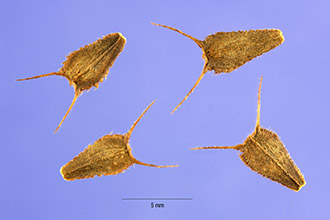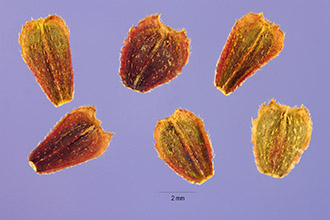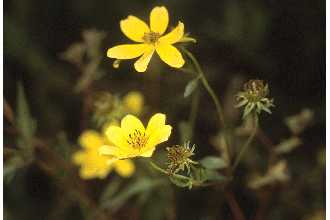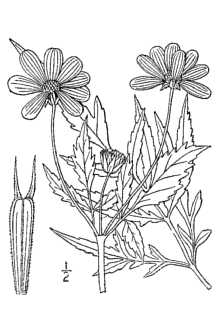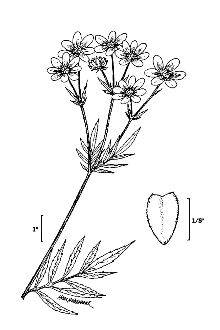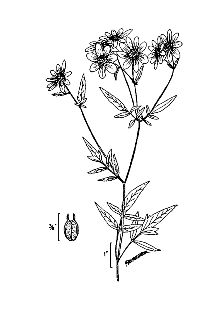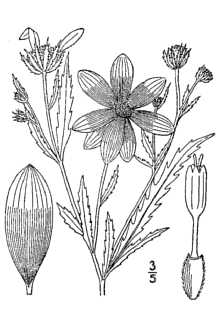Bidens aristosa (Michx.) Britton var. retrorsa (Sherff) Wunderlin
Scientific Name: Bidens aristosa (Michx.) Britton var. retrorsa (Sherff) Wunderlin
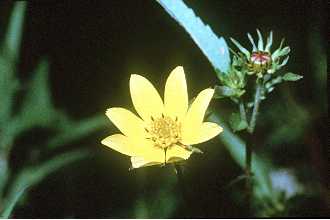
| General Information | |
|---|---|
| Usda Symbol | BIARR |
| Group | Dicot |
| Life Cycle | AnnualBiennial, |
| Growth Habits | Forb/herb |
| Native Locations | BIARR |
Plant Guide
Use soil moisture sensors to measure the soil moisture of Bidens aristosa (Michx.) Britton var. retrorsa (Sherff) Wunderlin.
Fact Sheet
Alternate Names
beggar ticks
Uses
This plant is used mainly for landscape beautification, Use soil moisture sensors to measure the soil moisture of Bidens aristosa (Michx.) Britton var. retrorsa (Sherff) Wunderlin., It has potential for use in cultivated, garden situations, in naturalized prairie or meadow plantings, and along roadsides,
Status
Please consult the PLANTS Web site and your State Department of Natural Resources for this plant’s current status (e.g. threatened or endangered species, state noxious status, and wetland indicator values).
Description
Bur marigold is an upright annual herb (1-5 feet tall) with a tap root. The alternate leaves are pinnately or bipinnately dissected, with each segment lanceolate and toothed or lobed on the margin. Plants produce numerous solitary flower heads held on long stalks from September to October; each head is 1-2 inches across and bright yellow with a yellow center. Seeds are dark brown, flattened, and have two prongs that project from one end.
Adaptation and Distribution
Distribution
Distribution
Bur marigold grows and flowers best in full sun, but is also adapted to partial shade. Plants are often found growing in open shade along the edge of a woodland. It is adapted to most soil types, except for very sandy soils. Natural stands are generally found on moist sites such as in ditches, marshes, and wet meadows. Bur marigold is distributed throughout the eastern and midwest United States. For a current distribution map, please consult the Plant Profile page for this species on the PLANTS Website.
Establishment
Seed should be planted from August to October. The seed will not germinate until the following spring, but it requires exposure to cool, moist conditions during the winter. A firm seedbed is required. Bur marigold germinates best on a clean tilled site that has been firmed with a roller or finishing harrow before planting. Seed can also be planted into a closely mowed, chemically-killed, or burned sod area with a light disking or harrowing that scratches the soil surface. A thick layer of plant residue on the soil surface can interfere with seed germination. Broadcast or shallowly drill 4-6 grams seed per 100 square feet (4-6 lb/acre). Planting depth should range from at the surface to one-quarter of an inch deep. Cultipacking after planting will ensure good seed to soil contact.
Plant Traits
Growth Requirements
| Temperature, Minimum (°F) | 52 |
|---|---|
| Adapted to Coarse Textured Soils | No |
| Adapted to Fine Textured Soils | Yes |
| Adapted to Medium Textured Soils | Yes |
| Anaerobic Tolerance | Medium |
| CaCO3 Tolerance | Medium |
| Cold Stratification Required | No |
| Drought Tolerance | Low |
| Fertility Requirement | Medium |
| Fire Tolerance | Low |
| Frost Free Days, Minimum | 140 |
| Hedge Tolerance | None |
| Moisture Use | High |
| pH, Maximum | 7.0 |
| pH, Minimum | 5.0 |
| Precipitation, Maximum | 55 |
| Precipitation, Minimum | 22 |
| Root Depth, Minimum (inches) | 8 |
| Salinity Tolerance | None |
| Shade Tolerance | Intermediate |
Morphology/Physiology
| After Harvest Regrowth Rate | Slow |
|---|---|
| Toxicity | None |
| Shape and Orientation | Erect |
| Nitrogen Fixation | None |
| Resprout Ability | No |
| Active Growth Period | Spring, Summer, Fall |
| Bloat | None |
| C:N Ratio | Medium |
| Coppice Potential | No |
| Fall Conspicuous | No |
| Fire Resistant | No |
| Flower Color | Yellow |
| Flower Conspicuous | Yes |
| Foliage Color | Green |
| Foliage Porosity Summer | Moderate |
| Foliage Texture | Coarse |
| Fruit/Seed Color | Brown |
| Fruit/Seed Conspicuous | Yes |
| Growth Form | Single Crown |
| Growth Rate | Rapid |
| Height, Mature (feet) | 3.5 |
| Known Allelopath | No |
| Leaf Retention | No |
| Low Growing Grass | No |
| Foliage Porosity Winter | Porous |
Reproduction
| Propagated by Seed | Yes |
|---|---|
| Propagated by Sod | No |
| Propagated by Sprigs | No |
| Propagated by Tubers | No |
| Fruit/Seed Persistence | Yes |
| Seed per Pound | 130000 |
| Seed Spread Rate | Rapid |
| Seedling Vigor | High |
| Small Grain | No |
| Vegetative Spread Rate | None |
| Propagated by Corm | No |
| Propagated by Container | No |
| Propagated by Bulb | No |
| Propagated by Bare Root | No |
| Fruit/Seed Period End | Fall |
| Fruit/Seed Period Begin | Summer |
| Fruit/Seed Abundance | High |
| Commercial Availability | Routinely Available |
| Bloom Period | Late Summer |
| Propagated by Cuttings | No |
Suitability/Use
| Veneer Product | No |
|---|---|
| Pulpwood Product | No |
| Protein Potential | Low |
| Post Product | No |
| Palatable Human | No |
| Palatable Graze Animal | Low |
| Palatable Browse Animal | Low |
| Nursery Stock Product | No |
| Naval Store Product | No |
| Lumber Product | No |
| Fodder Product | No |
| Christmas Tree Product | No |
| Berry/Nut/Seed Product | No |

